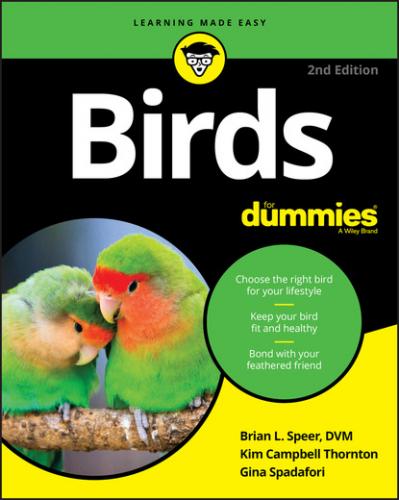The conures of the genus Pyrrhura are smaller and not nearly as loud. The green-cheeked, maroon-belly, and black-capped conures are the most popular in this group. Like the parrotlets and lineolated parakeets, green-cheeked conures can be quite the rock stars, easily learning many tricks and behaviors.
Conures range in price from $200 or so for some of the Pyrrhura to considerably more for flashier or rarer species or color variants, up to as much as $3,000. Life expectancies for healthy, well-cared-for birds can run from the twenties to the forties.
Caiques
There are two species of caiques: white-bellied and black-capped. The names are a tad deceiving, because both kinds have white fronts. The black caps have — you guessed it — black heads. Caiques are lively, busy birds, highly entertaining as companions, and real clowns. Everybody’s business is a caique’s business. They often want to be a part of whatever is going on or whatever they can get started! Their popularity is solid, and for good reason.
Like most of the medium-size parrots, life spans range from the twenties on up for healthy, well-cared-for birds. You can find caiques at a price range of $900 to $2,000, with most falling into the $1,200 to $1,500 range.
Large parrots
Flashy, colorful, noisy, intelligent, and talkative, large parrots are the ones folks usually visualize when they hear the word parrot, partially because some of these guys can really talk! You can find some excellent companions among these birds — and some challenging ones, too. But don’t expect to ever run across one that isn’t a parade-stopper — these birds have star status, without a doubt!
Amazons
Clever, colorful, talkative, and often bratty, Amazon parrots are sometimes considered a handful — but within the group you can find some species that defy commonly held beliefs.
First, the characters: There are about 30 species of Amazon parrots. Amazons undoubtedly have command presence. The yellow-naped and double yellow-heads are generally good talkers, but they can also be loud and demanding. They have the potential to become possessive of the person they may perceive as a mate, leading to the misleading description of being a “one-person bird.” You need to know about these possibilities before you start out with an Amazon. Some people like their in-your-face attitude; some don’t.
Other Amazons may be easier to live with, among them the lilac crowns, red-lored, blue-fronted, and white-fronted. These smaller species are less likely to push, are generally quieter, and are typically easier to handle. The trade-off: Their talking ability is usually not as good as that of the yellow-naped or double yellow-head.
Life expectancies for Amazon parrots are among the longest of pet birds; up to a hundred years is possible, particularly because we now better understand what it takes to keep these birds healthy. Unfortunately, poor diets and lousy care limit the life expectancy potential of many of these impressive birds; most of the pet population is gone long before the age of 50, with geriatric problems showing up in birds as young as 20 years old. Prices typically range from $500 to $2,500.
African greys
Introducing the undisputed Einsteins of the parrot world! African greys — both the more common Congo and the smaller Timneh — are marvelous talkers who have demonstrated that they actually understand what they’re saying.
Cockatoos
Cockatoos have a reputation as “love sponges” — birds who, in some folks’ minds, would choose to be “surgically grafted” onto their human companion. That’s only half the story, though. Cockatoos are often said to come in two basic behavioral types: the “love sponge” and the “hyperactive child.”
The “hyperactive child” is best represented by Goffin’s and bare-eyed cockatoos. Not always so keen on snuggling, these clowns never met a toy (or cage door) they couldn’t figure out and take apart. Some of these birds require padlocks on their cages to keep them from escaping — and not combination locks, either! Goffin’s and bare-eyeds learn trick behaviors quickly and perform them with great enthusiasm. These guys really need to have lots of jobs to do. Keeping their minds and bodies engaged is an essential part of helping them maintain a balanced life with you.
Living with a cockatoo means never a dull moment in your household, that’s for sure. Prices range from $700 for some of the smaller species, such as Goffin’s cockatoos, or $1,000 to $5,000 for species such as umbrella cockatoos, Moluccans, or Major Mitchell’s. Rare species such as some of the black cockatoos can run $20,000 and up. Life expectancies can theoretically hit 100 years for the larger species, although in most countries, birds over 60 to 70 years are relatively uncommon. Most can and should live longer through better care and nutrition.
Photograph courtesy of Rachel Baden, DVM
FIGURE 2-6: Galahs, sometimes referred to as rose-breasted cockatoos, aren’t necessarily cuddlers but they are friendly and affectionate.
